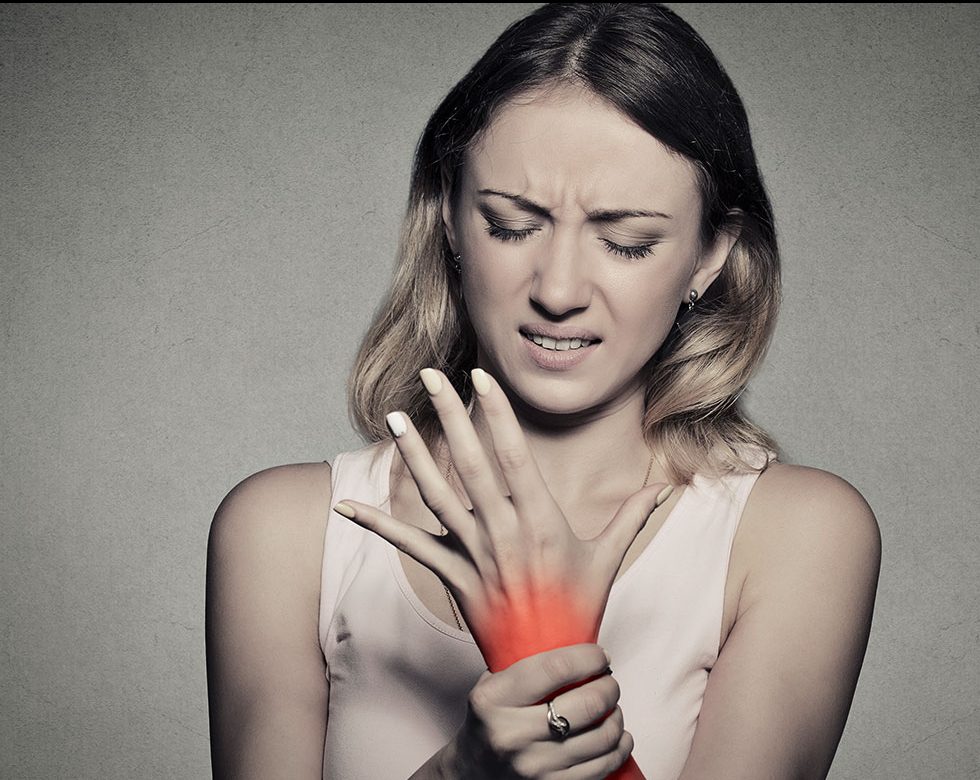
FEATURE — Dealing with chronic pain can be a frustration on a person’s physical and mental health — especially when the exact origin of suffering is difficult to pinpoint.
Complex regional pain syndrome – or CRPS – is a form of chronic pain that is caused by debilitating neuropathic disease. It often starts after a traumatic injury or surgery, but the pain is out of proportion to the original injury. Symptoms include abnormal hair or nail growth, swelling, temperature changes, color changes of the skin, weakness, decreased range of motion, sensitivity to touch and intense burning pain at the affected site.
Factors associated with CRPS
There are two major factors associated with CRPS. The first is that of hyperalgesia, which is extreme sensitivity to a normally painful stimuli. An example would be like being pinched. This would cause pain but usually for only a short period of time. In a patient with CRPS this sensation would cause prolonged intense pain.
The second factor is that of allodynia. Allodynia is described as pain experienced by something that normally would not cause pain. For example, a bed sheet brushing over the skin affected by those with CRPS would cause an intense burning pain or discomfort.
What are my treatment options?

Medical literature suggests that earlier diagnosis of CRPS and treatment will lead to better outcomes. Although there is no cure for CRPS, there are multiple options for the patient.
Providers use various types of medications to treat CRPS. Over-the-counter medications such as Tylenol, Ibuprofen or Naproxen are often used for pain and inflammation. Prescription strength pain relievers may also be an option. Antidepressants such as Amitriptyline and Cymbalta are a consideration, as are anticonvulsants – such as Gabapentin – which are used to help with the nerve pain.
Other options include active mobilization physical therapy, pharmacological therapy, sympathetic nerve blocks and possible spinal cord stimulation. Your surgeon or primary care physician would start with the physical therapy and some type of medication treatment. If these fail to address the problem, a referral to a pain management center may be made for sympathetic nerve blocks or consideration of a spinal cord stimulator.
Sympathetic nerve blocks target a group of nerves that are part of the autonomous nervous system. These spread to the parts of your body that help with involuntary function. This procedure is done in a series of injections under fluoroscopy (live X-ray), and medication is injected to help reduce the pain. These injections may be repeated if and when the CRPS symptoms return or worsen.

A spinal cord stimulator is a device that is surgically implanted and helps to lessen the intensity of pain. This is done by placing small electrodes within the spinal canal region to help lessen the pain signal traveling from the affected limb to the sensors in the brain. The result is a tingling sensation rather than the pain.
Prior to having the permanent device placed, a four- to five-day trial would be performed. This is done as an office procedure in a fluoroscopy suite at a pain management office. During the trial period, 50 percent improvement is needed to proceed with permanent placement.
If you feel like you may suffer from CRPS talk with your health care provider to begin final diagnosis or call the Desert Pain Specialists at 435-216-7000 for a consultation.
Written by CORTNEY BERNARDO, Desert Pain Specialists.
• S P O N S O R E D C O N T E N T •
About Desert Pain Specialists
Desert Pain Specialists is Southern Utah’s premier interventional pain management team. The doctors and the entire staff at Desert Pain Specialists are dedicated to helping patients find relief from their pain.
Desert Pain Specialists is located in the new Riverfront Medical Center, 617 E. Riverside Drive, Suite 301 in St. George. The team has additional offices at 1760 N. Main St. in Cedar City and 340 Falcon Ridge Parkway, Suite 600, in Mesquite, Nevada.
Resources
- Desert Pain Specialists | Telephone: 435-216-7000 | Email: [email protected] | Website.
- Locations:
- St. George: 617 E. Riverside Drive, Suite 301.
- Cedar City: 1760 N. Main St.
- Mesquite, Nevada: 340 Falcon Ridge Parkway, Suite 600.
Email: [email protected]
Twitter: @STGnews
There’s also a cute little plant called cannabis that grows easier than a tomato and many say it relieves them of their pain, but THE LORD’S ONE TRUE CHURCH (or whatever they’re calling it these days) needs to keep pharma’s profits strong and keep the people hooked on their chemical poisons. Keep those people hooked up on their lyrica or cymbalta or w/e other kind of poison for life, or invasive and risky surgical injections and implants like what’s discussed here.
Amen brother, that’s exactly how they “hook you up” just as soon as you get a good job with good insurance. I’ve had major episodes of depression that last years, I’ve been on Cymbalta a few times at the strongest dosage and it never did anything for me, but I can tell you what does work for me; a 500MG DISPOSABLE VAPE PEN loaded with “Dream Catcher” with 84% THC at $65 a pop! I take one single hit off the Vapor Pen, and spend 4-5 hours laughing about anything & everything! That’s “One” hit.
Depression cannot survive in a host that is happy to flood their system with laughter, and the endorphins laughter releases.